The aim of the LIFE Bear-Smart Corridors initiative is to enhance human-bear coexistence in Italy, Greece, and further afield. The initiative’s well-attended first two public meetings, in the towns of Pettorano sul Gizio and Vastogirardi in the Central Apennines rewilding landscape, proved very positive and educational events.
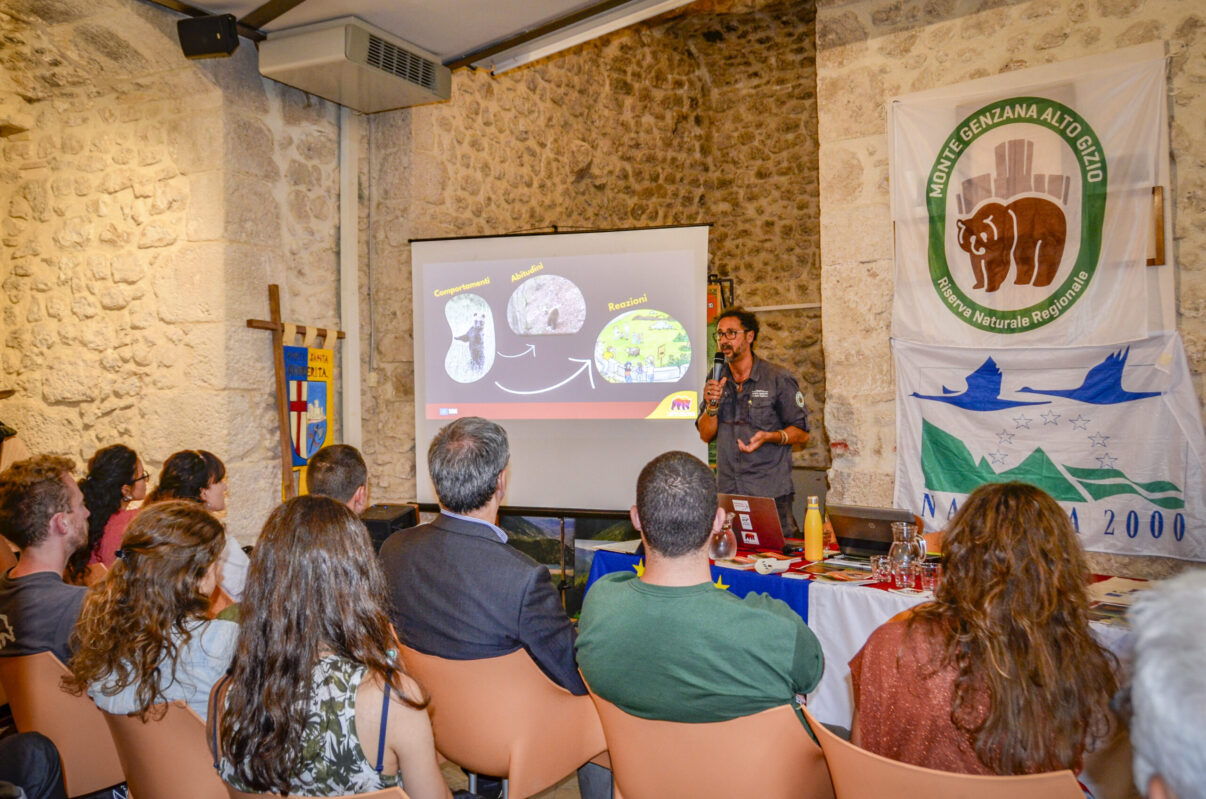
Fostering coexistence
Today, with many key European wildlife species making a comeback – and efforts underway to recover the populations of a wide range of others – fostering greater levels of human-wildlife coexistence is increasingly important.
Coordinated by Rewilding Europe, the LIFE Bear-Smart Corridors initiative is a coalition of 12 Italian and Greek partners working to enhance brown bear populations through the development of coexistence corridors. Within these corridors, which are typically large-scale, populated tracts of land connecting parks and other protected areas, local communities are learning to live peacefully alongside bears, such as they are with the critically endangered Marsican brown bear in Rewilding Europe’s Central Apennines rewilding landscape. In turn, the gradual recovery of this iconic species is delivering economic and cultural benefits, as well as ecological ones, on a growing scale.

A best-practice example
 With the objective of building engagement and promoting coexistence, the first public workshops connected with the LIFE Bear-Smart Corridors initiative were held in the past few weeks. The first venue for the meeting was the beautiful town of Pettorano sul Gizio, one of the so-called “Bear-Smart Communities” that are being developed by the Rewilding Apennines team, together with other local organisations and institutions, within a network of wildlife corridors. Such communities employ a number of measures to promote coexistence with bears, such as the installation of electric fences, the use of bear-proof bins, and the restoration of abandoned orchards.
With the objective of building engagement and promoting coexistence, the first public workshops connected with the LIFE Bear-Smart Corridors initiative were held in the past few weeks. The first venue for the meeting was the beautiful town of Pettorano sul Gizio, one of the so-called “Bear-Smart Communities” that are being developed by the Rewilding Apennines team, together with other local organisations and institutions, within a network of wildlife corridors. Such communities employ a number of measures to promote coexistence with bears, such as the installation of electric fences, the use of bear-proof bins, and the restoration of abandoned orchards.
“The overarching aim is to act as a best practice example for human-bear coexistence, with the ultimate aim of establishing Bear-Smart Communities across Europe,” explains Rewilding Apennines Communications Manager Angela Tavone. “We chose Pettorano sul Gizio as the location for the first meeting because it was the first such community set up in the Central Apennines in 2015. On reflection, the event was a great success.”
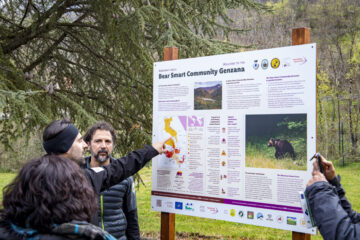

A diverse programme
The meeting was held in Pettorano sul Gizio’s picturesque castle. Around 70 people attended the event – most were residents of the town, but some also came from the surrounding valley.
Antonio Di Croce, Director of the Monte Genzana Alto Gizio Nature Reserve, within which the town of Pettorano sul Gizio is situated, talked about the main threats faced by the Marsican brown bears of the Central Apennines, and ways to live in harmony with these large if typically shy and retiring carnivores.
The Rewilding Apennines team then used two specially designed boards to explain the various measures employed to prevent bear damage, how to behave when encountering a bear in the wild, and the various actions the team and partners are taking to support coexistence.
They also talked about how so-called “bear intervention units” will soon be established, made up of people connected to local institutions and the town itself. As part of the LIFE Bear-Smart Corridors initiative, five of these units will be established across the Central Apennines rewilding landscape – they will act as focal points for local people to ask bear-related questions and report encounters with or sightings of bears.

Scaling up the bear-smart concept
An equally successful second workshop took place in Vastogirardi, in the Alto Molise area. In a room packed with over 60 people, Annette Mertens, Rewilding Europe’s LIFE coordinator, illustrated the objectives of the initiative, while Serena Frau of Salviamo l’Orso and Angela Tavone talked about the biology of the Marsican brown bear, the concept of Bear-Smart Communities and how to commit to becoming one. A special contribution by veterinarian dr. Antonio Liberatore allowed the participants to gain an even more in-depth understanding of bear behaviour.
“The audience was truly curious and open to learn,” added Tavone about the second event. “We received many questions during the meeting and lots of positive feedback and comments afterwards.”
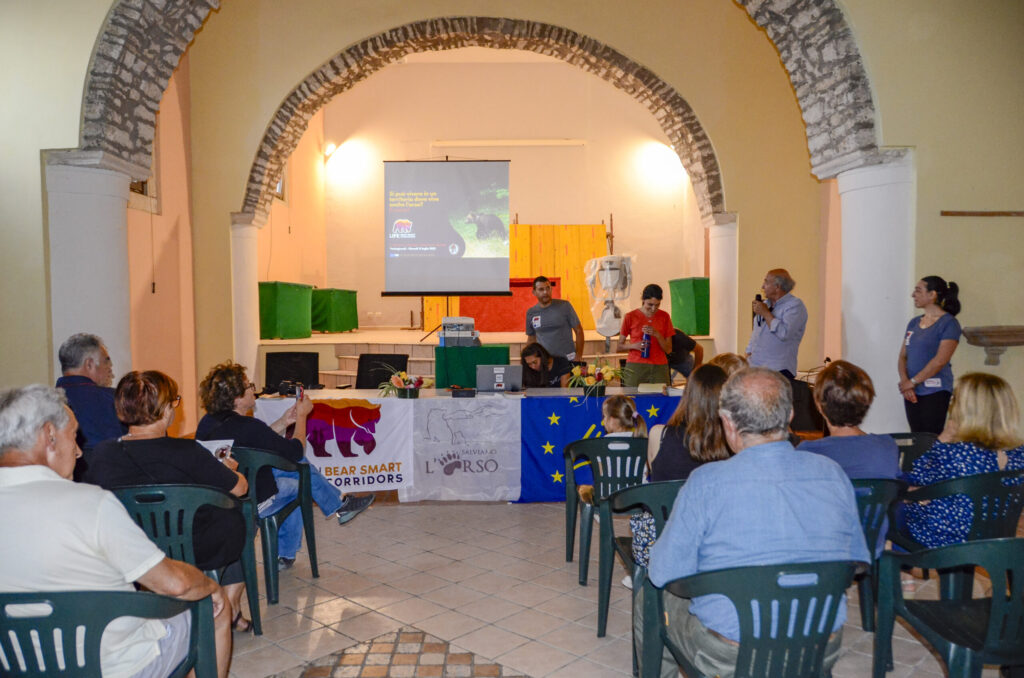
Positive feedback
During the interactive part of both events, participants were presented with three boards, designed to allow them to express their feelings and opinions about bears. One focused on the challenges of living in a landscape where bears are present and need to be protected, one on what individuals and organisations could do to improve the future of Marsican brown bears, and the last board asked people to imagine what they thought a newspaper might write about the achievements in their Bear-Smart Community in 2063. Participants were also asked to record their positive and negative emotions regarding bears on a so-called “emotions wheel”.
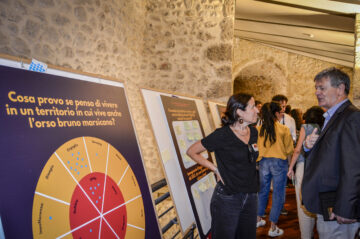
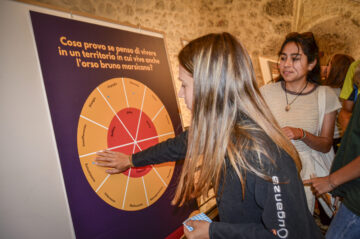
With participants enjoying some local food produced by members of the Bear Fund Network – local nature-based enterprises who are being trained to become ambassadors for human-bear coexistence -, this interactive session generated interesting and positive results. By far the most common emotions generated by Marsican brown bears were pride and enthusiasm. Challenges related to bears in the landscape included difficulties in changing people’s behaviour and their indifference to human-wildlife coexistence, as well as incorrect information presented in the media. Many participants expressed a desire to enhance coexistence further by spreading the knowledge and information they had gained from the workshop amongst friends, family and other associates.

“The mood of the meetings was friendly and optimistic, and many local residents who had concerns about bears before the event went away happier and more inspired,” says Angela Tavone. “There will be at least ten such meetings held in the Central Apennines rewilding landscape as part of the LIFE Bear-Smart Corridors initiative, so we will put the specially designed boards to good use. Based on the outcome in Pettorano sul Gizio and Vastogirardi, I’m confident these events will increase the acceptance of bears across the rewilding landscape.”
